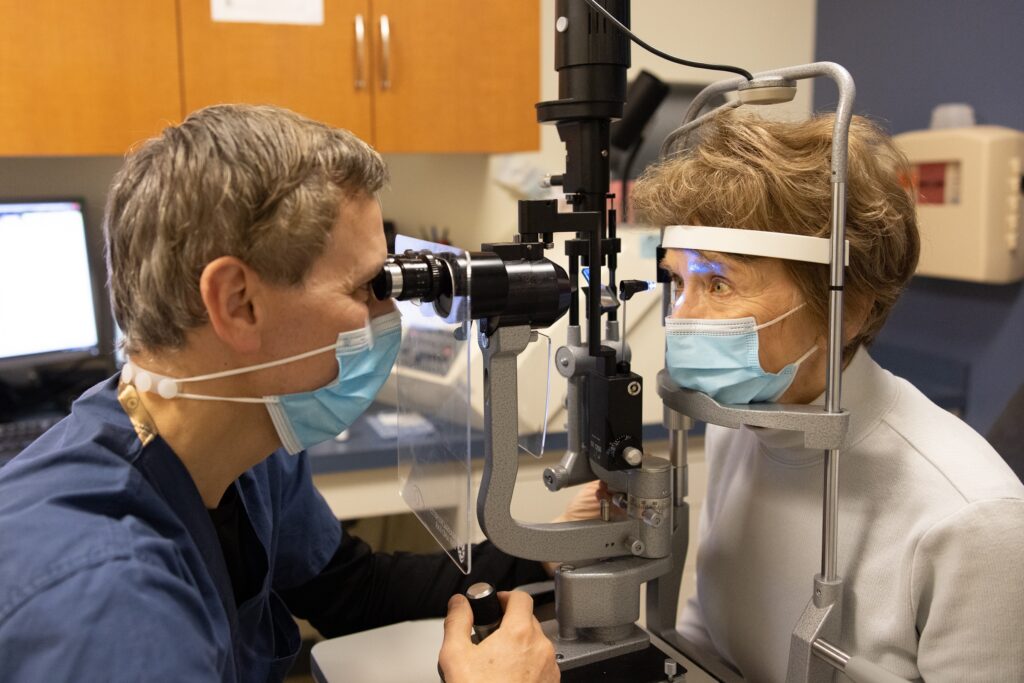In a recent article in The Lancet, David S. Friedman, MD, PhD, MPH, director of the Glaucoma Service at Mass Eye and Ear, and colleagues describe the current state of glaucoma care and what advances the future might bring to patients. In this Q+A, he discusses how far treatment has come and what can be expected in the near future.
Glaucoma is currently the second-leading cause of blindness worldwide, and in the United States alone, about 3 million Americans live with glaucoma. Glaucoma is often referred to as the “sneak thief of sight” because many people do not realize they have it until the disease is severe. The damage from glaucoma is irreversible, so earlier detection and treatment is essential to avoid unnecessary blindness.
In the paper published last month in The Lancet, David S. Friedman, MD, PhD, MPH, director of the Glaucoma Service at Mass Eye and Ear and colleagues discuss the tremendous need for better detection and treatment of glaucoma. Dr. Friedman spoke with Focus to describe some of the current limitations in glaucoma care and what research is underway to improve care for patients.
What exactly is glaucoma?
Glaucoma is a specific form of damage to the optic nerve. The optic nerve is the cable that connects your eye to your brain and if it is damaged, vision is not normal. Early in glaucoma there are usually few or no symptoms. As it gets worse, there can be some difficulty when going from bright to dark or from dark to bright. Later in the disease the side (peripheral) vision is lost, and it can be difficult to do many daily activities like moving around easily and reading.
How does glaucoma impact the daily lives of your patients?
Patients with glaucoma have several limitations: They are more afraid of falling and fall more frequently, they walk more slowly and reading is more difficult than for those without glaucoma. With more advanced disease they are more likely to stop driving. Severe glaucoma can lead to substantial limitations, but fortunately, most patients under care retain good useful vision.

Who is more at risk for glaucoma?
Glaucoma is much more common with aging, so older people are more likely to have glaucoma than younger people. Glaucoma is also more common in certain groups with African Americans having nearly four times the rate of Whites. Hispanic populations, especially older ones, also have high rates that are similar to African Americans.
Can glaucoma be cured?
Glaucoma cannot be cured. The damage to the nerve that occurs, at present, cannot be reversed. That said, our treatments, which can include eye drop medications, laser treatments and surgery, can help retain the remaining vision and the great majority of patients are mostly stable when under care. Many promising new therapies are being investigated that may lead to vision restoration in glaucoma patients, but none are presently available for care.
What are some of the current knowledge gaps in glaucoma care?
Research is uncovering more information about glaucoma than ever before, such as the role of certain genes in glaucoma. Despite this incredible progress, we still do not have a perfect screening test that could be administered easily and accurately to identify glaucoma patients. Many do not realize they have glaucoma until the disease is advanced. We also struggle determining which patients are getting worse despite being treated for glaucoma. Improvements here would allow for more rapid and targeted interventions for patients.
There also are treatment gaps at present. The only effective treatment for glaucoma remains lowering eye pressure. Yet, about half of all patients with glaucoma have intraocular pressure in the normal range so factors other than eye pressure play an important role in why some people get glaucoma. We need treatments that protect the nerve through other means.

What are some innovative areas of research that excite you for the future?
There are several areas of study that are quite exciting and suggest a brighter future ahead.
Better testing of patients should be widely available in the coming years. There are several companies that have developed virtual reality headsets that can test vision and side vision and these likely will become a standard approach to monitoring glaucoma over time.
For treatment, improved delivery of eye medications should occur soon. Some approaches allow for long-term delivery of eye pressure lowering medications through implanted devices in the eye, or by wearing a contact lens that can deliver drug. Perhaps even more exciting are novel approaches to protect the nerve or to regenerate the nerve including gene therapy and stem cell therapy. These approaches are still in early development but hopefully can lead to clinical trials over the next few years. Gene therapies are currently used for other retinal conditions, such as forms of inherited retinal blindness. Research into stem cells is also promising, and some day we may be able to transplant these cells to replace the tissues damaged in glaucoma.
Another exciting approach being actively researched looks at how to apply our knowledge of glaucoma genetics to provide personalized care to patients. Some treatments may work better with patients with specific genes, for example. There are numerous studies underway, including several at Mass Eye and Ear, that are using genetics, artificial intelligence and advanced imaging to develop personalized risk scores for patients that could better predict how their glaucoma will progress, which might lead to better and more personalized care.
How has glaucoma care evolved since you started practicing, and where do you see disease management evolving over the next 5 years?
There have been major advances in how we image the nerve and the nerve fiber layer that have greatly improved our ability to monitor patients and diagnose glaucoma. This has been a dramatic change. We also have safer procedures for lowering eye pressure. While these are important advances that have benefitted our patients, much still needs to be done.
We now have tremendous knowledge about the genetics of glaucoma, and this will transform how we care for patients in the coming years.
There is also a lot more clinical trials evidence for how we should be treating patients with glaucoma.




